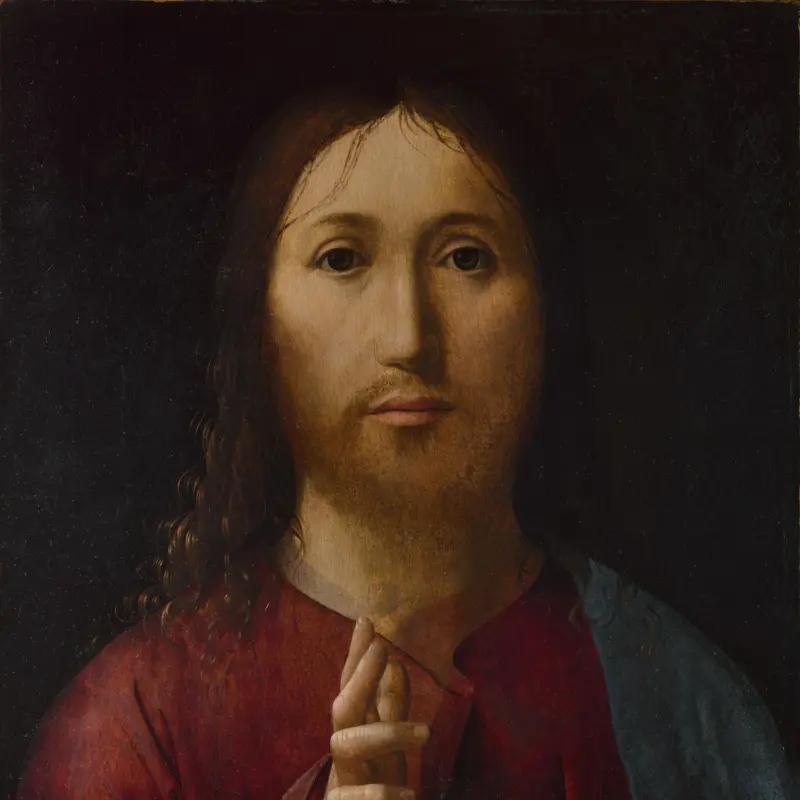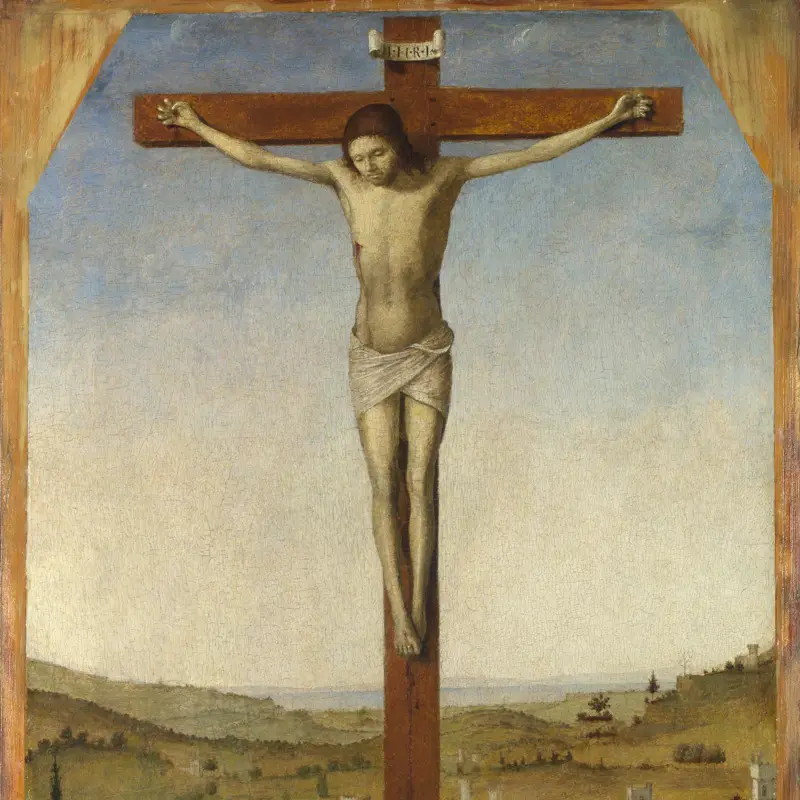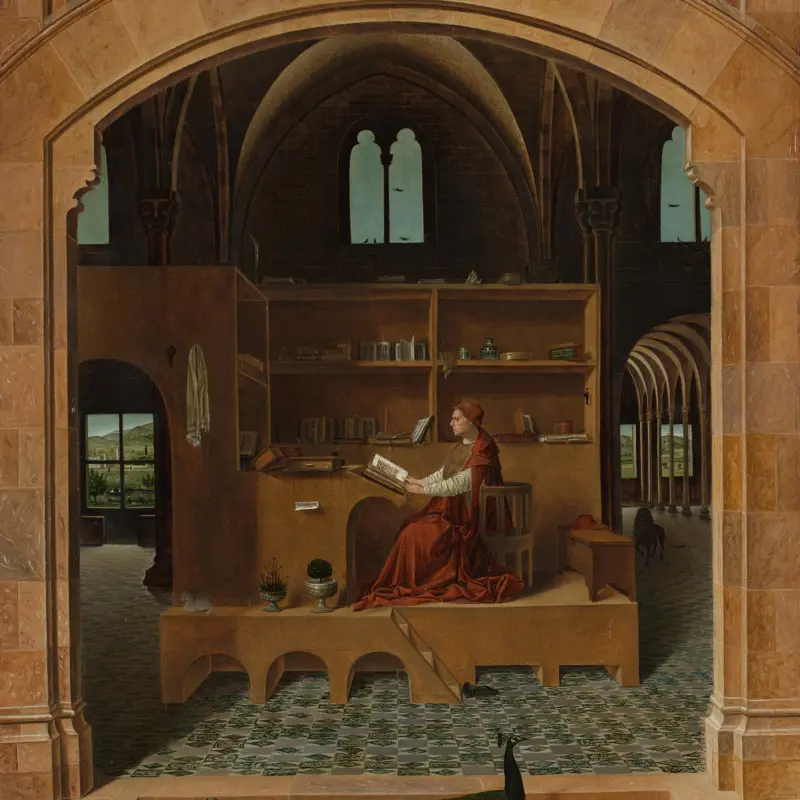Antonello da Messina, 'Portrait of a Man', about 1475-6
About the work
Overview
This small painting shows how Antonello revolutionised Venetian portraiture in the late fifteenth century: the three-quarter pose, dark background and strong lighting are all innovations from Northern Europe which focus attention entirely on the man’s face.
Antonello’s skill at painting in oil enabled him to mimic the very precise painting style of northern masters like van Eyck, whose works were highly sought after in Venice where he travelled around the time this picture was made. By building up colour through layers of varied shades he was able to emphasise the volume and contours of the face using colour, rather than harsh lines. The glossiness of the oil paint adds shine to the man’s eyes so they look as if they are catching the light.
These techniques made Antonello’s portraits vivid, intense and lifelike. His successful formula for painting portraits was quickly adopted by his contemporaries.
Key facts
Details
- Full title
- Portrait of a Man
- Artist
- Antonello da Messina
- Artist dates
- Active 1456, died 1479
- Date made
- About 1475-6
- Medium and support
- Oil on wood
- Dimensions
- 35.6 × 25.4 cm
- Acquisition credit
- Bought, 1883
- Inventory number
- NG1141
- Location
- Room 51
- Collection
- Main Collection
- Frame
- 16th-century Venetian Frame
Provenance
Additional information
Text extracted from the ‘Provenance’ section of the catalogue entry in Martin Davies, ‘National Gallery Catalogues: The Earlier Italian Schools’, London 1986; for further information, see the full catalogue entry.
Exhibition history
-
2008Renaissance Faces: Van Eyck to TitianThe National Gallery (London)15 October 2008 - 18 January 2009
Bibliography
-
1870G. Campori, Raccolta di cataloghi ed inventarii inediti di quadri, statue, disegni, bronzi, dorerie, smalti, medaglie, avorii, ecc, Modena 1870
-
1871J.A. Crowe and G.B. Cavalcaselle, A History of Painting in North Italy: Venice, Padua, Vicenza, Verona, Ferrara, Milan, Friuli, Brescia, from the Fourteenth to the Sixteenth Century, 2 vols, London 1871
-
1883'The Latest Addition to the National Gallery', The Times, 31 May 1883
-
1884London, National Gallery Archive, NG17/4 Annual Reports 1874-1886: Annual Report for 1883, 1884
-
1885National Gallery, Abridged Catalogue of the Pictures in the National Gallery: With Short Biographical Notices of the Painters: Foreign Schools, London 1885
-
1887F. Kugler, Handbook of Painting: The Italian Schools, eds C.L. Eastlake and A.H. Layard, 5th edn, London 1887
-
1888E.T. Cook, A Popular Handbook to the National Gallery Including, by Special Permission, Notes Collected from the Works of Mr. Ruskin, London 1888
-
1895G. Gronau, 'Correspondance d'Angleterre: L'Art vénitien à Londres, a propos de l'exposition de la New Gallery', Gazette des beaux-arts, I, 1895
-
1899J.A. Crowe and G.B. Cavalcaselle, Storia dell'antica pittura fiamminga, Florence 1899
-
1901A. Venturi, Storia dell'arte italiana, 11 vols, Milan 1901
-
1907U. Thieme and F. Becker (eds), Allgemeines Lexikon der bildenden Künstler von der Antike bis zur Gegenwart, 37 vols, Leipzig 1907
-
1907L. Venturi, Le origini della pittura veneziana 1300-1500, Venice 1907
-
1914N. Scalia, Introduzione, note e commento alla vita di Antonello del Vasari, Florence 1914
-
1914N. Scalia, Antonello da Messina e la pittura in Sicilia, Milan 1914
-
1914R. Longhi, 'Piero dei Franceschi e lo sviluppo della pittura veneziana', L'arte, XVII, 1914
-
1933J. Lauts, 'Antonello da Messina', Jahrbuch der Kunsthistorischen Sammlungen in Wien, VII, 1933, pp. 15-88
-
1934R.N.D. Wilson, The National and Tate Galleries, London 1934
-
1939S. Bottari, Antonello da Messina, Milan 1939
-
1940J. Lauts, Antonello da Messina, Vienna 1940
-
1940F.J.G. Rawlins, From the National Gallery Laboratory, London 1940
-
1947P. Hendy, An Exhibition of Cleaned Pictures of 1947: (1936-1947), London 1947
-
1947M. Davies, 'Antonello da Messina by Jan Lauts; Mostra dei Dipinti di Antonello da Messina', The Burlington Magazine, LXXXIX/531, 1947, pp. 170-1
-
1951Davies, Martin, National Gallery Catalogues: The Earlier Italian Schools, London 1951
-
1952G. Vigni, Tutta la pittura di Antonello da Messina, Milan 1952
-
1953S. Bottari, Antonello, Milan 1953
-
1961M. Davies, The Earlier Italian Schools, 2nd edn, London 1961
-
1964R. Causa, Antonello da Messina, Milan 1964
-
1967L. Sciascia, L'opera completa di Antonello da Messina, Milan 1967
-
1975C. Gould and A. Smith, The Rival of Nature: Renaissance Painting in its Context, (exh. cat. The National Gallery, 10 June - 28 Sept 1975), London 1975
-
1979M.G. Paolini, 'Antonello e la sua scuola', in Storia della Sicilia, Naples 1979, vol. 5
-
1980J. Wright, 'Antonello da Messina: Origins of His Style and Technique', Art History, III/1, 1980, pp. 41-60
-
1981A. Marabottini and F.S. Santoro, Antonello da Messina, (exh. cat. Museo Regionale, 22 October 1981 - 31 January 1982), Rome 1981
-
1982P.H. Jolly, Jan van Eyck and St. Jerome: A Study of Eyckian Influence on Colantonio and Antonello Da Messina in Quattrocento Naples, London 1982
-
1983M. Warner, 'Focus: Smile and be a Villan', The Connoisseur, CCXIII/851, 1983, pp. 28-30
-
1983L. Puppi, 'Il viaggio ed il soggiorno a Venezia di Antonello da Messina', Museum Patavinum, I, 1983, pp. 253-82
-
1984L.C. Vegas, Italie et Flandres dans la peinture du XVe siècle, Milan 1984
-
1986Davies, Martin, National Gallery Catalogues: The Earlier Italian Schools, revised edn, London 1986
-
1986F. Sricchia Santoro, Antonello e l'Europa, Milan 1986
-
1987J. Wright, 'Antonello the Portraitist', in Antonello da Messina. Atti del convegno di studio tenuto a Messina dal 29 novembre al 2 dicembre 1981, Messina 1987, pp. 181-98
-
1990E. Markgraf, Antonello und die Niederlande, Frankfurt 1990
-
1991J. Dunkerton et al., Giotto to Dürer: Early Renaissance Painting in the National Gallery, New Haven 1991
-
1993L. Arbace, Antonello da Messina: Catalogo completo dei dipinti, Florence 1993
-
1993D. Thiébaut, Le Christ à la Colonne d'Antonello de Messine (exh. cat. Musée du Louvre, 13 May - 9 August 1993), Paris 1993
-
2000J. Dunkerton, 'Antonello da Messina e la tecnica fiamminga', in F. Simonetti (ed.), Ecce Homo: Antonello da Messina, Genoa 2000, pp. 26-32
-
2001
C. Baker and T. Henry, The National Gallery: Complete Illustrated Catalogue, London 2001
-
2006M. Lucco (ed.), Antonello da Messina: L'opera completa (exh. cat. Scuderie del Quirinale, 18 March - 5 June 2006), Milan 2006
-
2008L. Campbell et al., Renaissance Faces: Van Dyck to Titian (exh. cat., The National Gallery, London), London 2008
-
2008L. Syson et al., Renaissance Faces: Van Eyck to Titian (exh. cat. The National Gallery, 15 October 2008 - 16 January 2009), London 2008
About this record
If you know more about this work or have spotted an error, please contact us. Please note that exhibition histories are listed from 2009 onwards. Bibliographies may not be complete; more comprehensive information is available in the National Gallery Library.




